Vuth Lyno is one of the rising stars of Cambodia’s contemporary art scene. He’s a founding member of the art collective Stiev Selapak (meaning “art rebels”) and the director of the dynamic community-focussed art centre, Sa Sa Art Projects.
He’s also an openly gay man, a fact that’s only recently begun to influence his work. It began when he volunteered with Cambodian Gay Pride 2010 as a curator for an LGBT art exhibition, featuring both local and international artists.
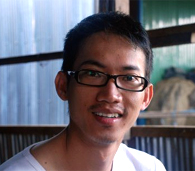
Then, in 2011, he took centre stage with a solo exhibition for Pride, called Thoamada. This is a Khmer word that roughly translates to “normal”, “casual” or “OK”. He’d created large close-up photos of the faces of nine gay and bisexual men, only disguised by having their face covered in facepaint. Each image was accompanied by a sound recording of a story from their lives.
During the workshop process, he’d noticed that a lot of the participants had the same answer when he asked them how they felt about their sexualities. “Thoamada,” they said. He liked that – it was a reflection of how normal LGBT people felt themselves to be in Cambodian society.
His follow-up work, Thoamada II, is opening this month on 26 January. It’s focussed on the families of LGBT people: lesbian mothers, gay and bisexual people with their parents, and so on. Once again, it involves storytelling: each conventional family photo is paired with a picture of an important family memory they’ve recreated for the camera.
If you live in Singapore, you’ll be able to catch Lyno earlier than this, on Saturday at 1pm, Jan 19. He’s speaking at Superintense, an all-week series of presentations by international artists.
If you go, you might want to watch out for other LGBT artists, including US choreographer Julie Tolentino and South African theatre director Brett Bailey.
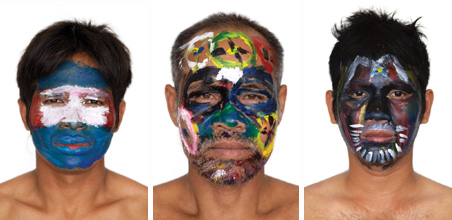
From left: Smoh Pit, Sou Pov, Lion, Thoamada series, 2011
æ: Age, sex, occupation, location?
Lyno: 30, male, artist, Phnom Penh.
æ: What was your inspiration for Thoamada?
Lyno: What happened was I left for my studies in 2008, 2009. And when I came back, I was quite surprised. Many changes had happened within those two years: young people dressing up, having a lifestyle and people talking more about the topic of gay people.
One person said, “It’s a new sector in Cambodia.” And I thought, “It’s not new.” And that motivated me to do this project and study the lives of gay men, to kind of say with these testimonials, “It’s not new: it’s always existed.”
æ: What was the first edition like?
Lyno: I invited nine MSMs to participate in a project with me where, they all came in and discussed issues related to sex, gender and sexual orientation. I wanted to create this environment or space where people could freely talk about something that is very personal, something that they do not normally have the chance to tell.
It was a very diverse profile of people. The age range was from 17 to somewhat under 50. And coming from many backgrounds: the city people; the people from the provinces; the ones that are working in professional, well-paid jobs compared to those who are farmers, and so on. At the end of the workshop I invited them to pose for a photograph. At first, because they were not out, they said, “I would like to, but I cannot. If you take my photograph people will know.”
So I had to promise them that we would do it in a way that their identities would be protected. I invited them to paint their own faces. They could choose any symbol, anything, basically paint anything. So people did. Some did so more intensively, like, a lot [of paint] on their faces, and some a little bit less. And I said, “OK, you’ve finished this?” “Oh yes.” “People will know who you are, because the way you’re painted still pretty much reveals what you look like.” And what really impressed me was people said, “That’s OK, it’s fine for them to know a little bit.”
So there was this positive shift from the beginning of the workshop. They were willing to come out, to be open and talk. And in the end I exhibited their portraits as a photo installation with sounds. I made a circular installation of photographs and there’s a sound recording the audience can listen to for each photograph. That sound is a recording of their personal stories.
æ: What are the stories about?
Lyno: I asked them to tell me some highlights of their life journeys. Some stories were about their childhood experience. Some said that when they were young they didn’t like to play any sports or games for boys. But other stories said “I play football, I hang out with my mates, and I fight other people a lot, because I don’t want them to cause trouble with me. So we have some real-life stories of how real humans break this stereotype or image of what “gay” is.
Also they talked about what it meant for them when they knew they liked the same sex. What’s interesting is there are many who say yes, they knew that they started to like men when they were young. But others said yeah, they observe and admire other guys who dress up well but they don’t have this feeling of love.
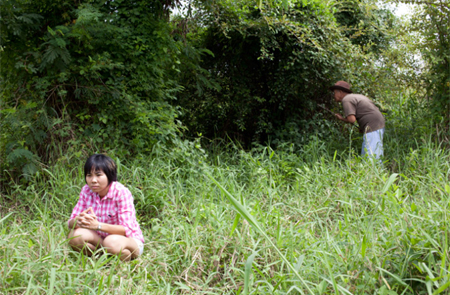
The Waiting Daughter, Thoamada II, 2012 (top and bottom)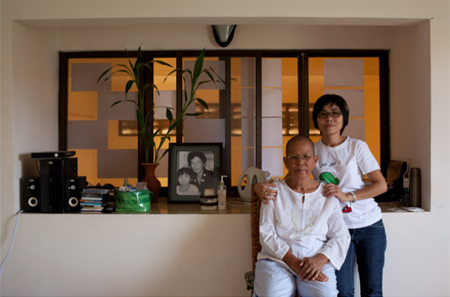
æ: What about Thoamada II?
Lyno: While Thoamada I looks at a personal narratives – personalities, stereotypes – in the second one I wanted to look beyond individuals to the family: how family is defined according to Cambodian LGBTs.
I went to visit the families of LGBT Cambodians and asked them how they as individuals came to know how to deal with the sexualities of their kids and whether they accept them or not. And what factors have worked to help them connect over time.
I did two photographs for each family. One photograph is normal family portraiture. I didn’t want to make anything provoking or anything that looks unusual, so I took what seem to be very usual family portraits. And how I did this was I let them decide how to pose themselves. I did not say, “You sit here, you sit there.” I wanted to see how the family perceives itself. How they sit tells us something as well.
The second photograph is a recreation of memory from their past. So I invited them to share what were memorable moments that they had: some as individuals, some as a family, then I invited them to pose and recreate that scene or moment together with me, around the house or nearby.
So, for example, one lesbian told me, “My mother was a soldier, and she went on missions to battles. I was always worried. I was waiting at home every day, and sometimes people would say, ‘Maybe she died.’” So we kind of co-shaped this scene together. We went to the back of her house, to the bushy environment, and she was posing, sad and waiting. And on the other side of the frame was her mother, wearing a green shirt and hat, and holding a stick to pretend it was a gun.
I’m interested in human stories. For me, we are all the same regardless gay and straight, and I’m interested in stories, including the stories that it don’t matter in relation to your sexuality. They demonstrates that your life experience doesn’t differ from other straight people. And I’d like to share our people’s stories to wider audience.
æ: Who have you photographed for this series?
Lyno: I have collected seven stories so far: a lesbian couple, a gay son, a lesbian daughter, one family that has one gay brother and one transgender brother, and also a transgender living with a straight man as a couple. As soon as I get back I will do one more story for the exhibition. If I can collect some more, I will put them in a book, with the photos accompanied with a short text form my interview with each family.
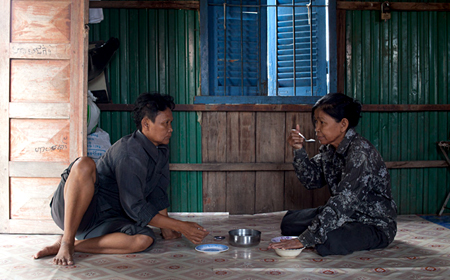
The Salt Seeker, Thoamada II, 2013 (top and bottom)
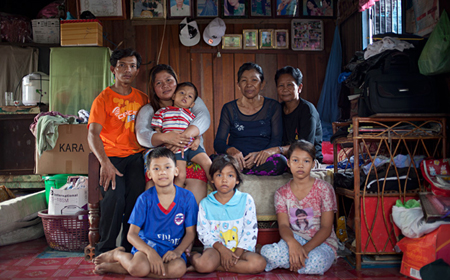
æ: What would you say is the biggest problem LGBT people face in Cambodia?
Lyno: But in terms of talking about rights, in Cambodia there is no law or anything that is strongly against LGBT people. But in that sense, there are no particular rights for support as well. It’s a bit blurry.
From my experience, meeting with people, it’s a lot about family and community acceptance. One of the very first steps that pushes LGBT out of society is family rejection. Most gay men are camouflaged: they can blend in with other people. But transgenders are very obvious. So in Cambodia, many transgenders leave home early, and this means they lack educational and financial support. To find their own income, they are forced to work in low-paying jobs, like the entertainment sector.
[Author’s note: one effect of gay men’s being closeted is that Cambodia’s LGBT rights movement is dominated by transgender people and lesbians.]
When I came out to my parents, at first it was horrible: there was a lot of crying, a lot of hatred, a lot of arguments. But then we cooled it down and I think it’s better. They don’t know my boyfriend yet. I feel like it’s a lot for them to take in over a short amount of time. I’ll give it to them bit by bit.
æ: How well do you think you’re represented as an artist by gay-themed work?
Lyno: Some people ask me, “So you’re working only on gay projects?” It’s not true. I’m interested in sub-communities and subcultures that are very unique to them.
It just happens that in Cambodia I was troubled by how LGBT projects mostly revolve around portraiture of transgender performances. The general public people sees this as gay, That’s not what “gay” means, and it’s misleading. I kind of want to fill in the narrative with what hasn’t said.
I’m very interested in other projects too. Especially Cambodian migrants: I hope to work with Cambodians living outside Cambodia. This year I will be going to US and to Australia, so I hope to start working with Cambodians there first.
Vuth Lyno will be speaking at Superintense at 1pm, Sat, 19 Jan at 72-13 Mohamed Sultan Road, Singapore. Admission is free, but please e-mail TheatreWorks for an invitation beforehand. For details, check http://flyingcircusproject2013.wordpress.com/schedule-singapore.
His exhibition Thoamada II will be open from 26 Jan to 2 Mar at SA SA BASSAC, #18 2nd Floor, Sothearos Blvd, Phnom Penh 3. For more information, visit http://www.sasabassac.com.











 Printable Version
Printable Version


















Reader's Comments
They met during the Khmer Rouge era, when everyone was starving. One woman asked the other for some salt, and the woman refused. And she thought (I'm quoting Lyno here), "Oh my god, this woman is so mean! But she’s so interesting."
So that's how they got together. And now they're married with two adopted daughters, one adopted son, and a few grandkids, too.
Please log in to use this feature.